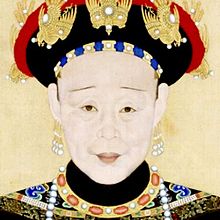Empress Xiaoherui
| Empress Xiaoherui | |||||
|---|---|---|---|---|---|
 |
|||||
| Empress Consort of the Qing dynasty | |||||
| Tenure | 1802–1820 | ||||
| Predecessor | Empress Xiaoshurui | ||||
| Successor | Empress Xiaoshencheng | ||||
| Empress Dowager of the Qing dynasty | |||||
| Tenure | 1820–1850 | ||||
| Predecessor | Empress Xiaoshengxian | ||||
| Successor | Empress Xiaojingcheng | ||||
| Born | 1776 | ||||
| Died | 1850 (aged 73–74) | ||||
| Spouse | Jiaqing Emperor | ||||
| Issue | Miankai, Prince Dun Mianxin, Prince Rui unnamed daughter |
||||
|
|||||
| House |
Niohuru (by birth) Aisin Gioro (by marriage) |
||||
| Father | Gong'ala (恭阿拉) | ||||
| Posthumous name | |
|---|---|
| Empress Xiaohegongcikangyu'anchengqinshunrenzhengyingtianxishengrui (孝和恭慈康豫安成欽順仁正應天熙聖睿皇后) |
| Empress Xiaoherui | |||||||
| Chinese name | |||||||
|---|---|---|---|---|---|---|---|
| Chinese | 孝和睿皇后 | ||||||
|
|||||||
| Lady Niohuru | |||||||
| Traditional Chinese | 鈕祜祿氏 | ||||||
| Simplified Chinese | 钮祜禄氏 | ||||||
|
|||||||
| Manchu name | |||||||
| Manchu script | ᡥᡳᠶᠣᠣᡧᡠᠩᡤᠠ ᡥᡡᠸᠠᠯᡳᠶᠠᠰᡠᠨ ᠰᡠᠩᡤᡳᠶᡝᠨ ᡥᡡᠸᠠᠩᡥᡝᠣ | ||||||
| Romanization | hiyoošungga hūwaliyasun sunggiyen hūwangheo | ||||||
| Transcriptions | |
|---|---|
| Standard Mandarin | |
| Hanyu Pinyin | Xiàohéruì Huánghòu |
| Transcriptions | |
|---|---|
| Standard Mandarin | |
| Hanyu Pinyin | Nǐuhùlù Shì |
Empress Xiaoherui (1776–1850) was the second Empress Consort of the Jiaqing Emperor of the Qing dynasty.
Empress Xiaoherui was born in the Manchu Niohuru clan. She was the daughter of Gong'ala (恭阿拉), who served as Secretary of the Ministry of Rites during the reign of the Qianlong Emperor.
Lady Niohuru entered the Forbidden City in an unknown year, and was married as a secondary consort to Yongyan (Prince Jia), the 15th son of the Qianlong Emperor. In 1793, she gave birth to Prince Jia's seventh daughter, but her daughter died in 1795 before reaching adulthood. She also bore Prince Jia two sons, Miankai and Mianxin, in 1795 and 1805 respectively. In 1796, the Qianlong Emperor abdicated and became Retired Emperor, while Prince Jia succeeded him and was enthroned as the Jiaqing Emperor. Lady Niohuru, as a former secondary consort of the emperor, was granted the rank of Noble Consort. When the Jiaqing Emperor's primary consort, Lady Hitara (Empress Xiaoshurui), died of illness after being Empress for only a year, Lady Niohuru was placed in charge of the emperor's harem and promoted to the rank of Imperial Noble Consort. The Jiaqing Emperor wanted to make Lady Niohuru his new Empress but had to wait until the mourning period for Empress Xiaoshurui was over. In 1799, the Retired Emperor (Qianlong Emperor) died so Lady Niohuru's promotion to Empress was delayed until 1801.
Lady Niohuru was in charge of the upbringing of Mianning, the Jiaqing Emperor's second son who was born to Empress Xiaoshurui. She took care of Mianning and treated him well, and they shared a close and harmonious relationship. When the Jiaqing Emperor died in 1820 before designating one of his sons as Crown Prince, the decision on the succession was left to Lady Niohuru, who became Empress Dowager. Lady Niohuru proclaimed Mianning the new emperor before an imperial edict was officially issued. She ordered her servants to deliver the message to Mianning, who was away in Chengde at the time. Mianning rushed back to the Forbidden City in Beijing and was enthroned as the Daoguang Emperor. The Daoguang Emperor was extremely pleased with Lady Niohuru's decision to make him emperor, claiming that she was broad-minded because she did not misuse her power to name any of her two sons (Miankai and Mianxin) as the new emperor. The Daoguang Emperor also granted Lady Niohuru the title "Empress Dowager Gongci" (恭慈皇太后). Empress Dowager Gongci moved to the Forbidden City's Palace of Longevity and Health, which was traditionally a residence of the emperor's mother.
...
Wikipedia
